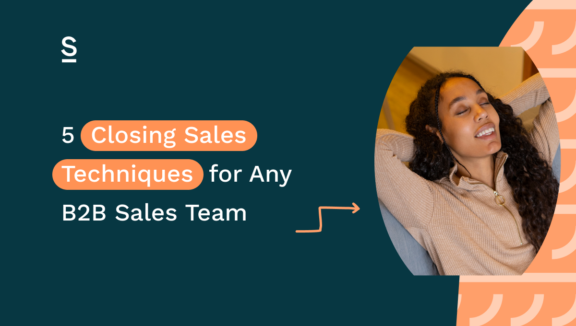5 Closing Sales Techniques for Any B2B Sales Team

Did you ever have a moment at school where you were sure you knew the answer…but you just didn’t put your hand up?
Us too.
It’s not a good feeling. Even more annoyingly, it’s followed us into our careers: 48% of sales calls end without an attempt to close the sale.
That’s a lot of wasted calls – which translates into wasted time and energy for you. Deals don’t just close themselves, and you need to make sure that you’re jumping at every opportunity to make it happen.
That doesn’t mean bulldozing every conversation with a blatant attempt to grab your prospects’ money, though. Instead, you need to employ precise strategies to convert leads into customers. Not every deal is the same, and the best salespeople out there have a whole roster of techniques to pluck from depending on the conversation they’re having.
If you’re thinking that you’d quite like to know some of these closing sales techniques, it’s your lucky day. In this blog post, we’re going to do just that. Here’s what we’re going to cover:
- Creating a Sense of Urgency
- Creating Internal Buy-In
- Flawless Follow-Up Strategy
- Be Assumptive in Your Approach
- Offering Personalized Discounts, Offers, or Custom Plans
By the end of this blog post, you’ll have plenty of actionable tips to put into action today. As a result, you should see your sales closing rates start to improve.
Assuming that’s a goal you like the sound of, let’s get started:
Closing Sales Technique 1: Creating a Sense of Urgency
Urgency is a crucial psychological drive in the decision-making process. The more immediately an action is taken, the less room there is for doubt or hesitation to creep in.
Why? Well, people are proven to be more likely to act on an urgent task than a non-urgent one – even when the urgent task is less important. This principle is called the mere urgency effect.
Think about it: do you struggle with leaving emails unread or Slacks not replied to, even if you’ve got a more important task at hand? That little red notification staring at you just too pressing to resist? That’s the mere urgency effect at hand.
Urgency is a super-effective technique – but crucially, it’s got to be done well. The last thing you want to become is a pushy salesperson who shoves a sale through before the prospect’s ready. That’s far more likely than not to cause problems later down the line. Here’s how to get this closing sales technique right:
Creating A Sense of Urgency Techniques
Time-limited offers: offer your prospect a sweet deal – but only if they close the sale within a limited time frame. This could look like a discount or a bonus to encourage a quick decision.
Scarcity tactics: the scarcity principle drives the value of a product up when it’s in short demand. Do the same for your product by openly discussing the limited availability of your product, or offering exclusive access to features if they close within a shorter time frame.
Here’s an example of how this might work in action. Meet Jill – she’s a salesperson at a company that’s got a really, really amazing product. Jill’s company currently has a small CS team, and as a result, they’re only able to onboard a certain number of customers a month. This has resulted in a waitlist.
Jill’s company’s product is really, really amazing – but it’s not unique. Jessica, our second salesperson, works at a very similar competitor. The only difference? This business has no problems onboarding customers – and no waitlist.
Jill and Jessica are going after the same prospect, and are both in the final stages of conversations. Jill casually mentions the waitlist, while Jessica doesn’t create a sense of urgency. Jill gets the sale, Jessica’s left scratching her head about why she missed out.
See what we mean? Good.
Closing Sales Technique 2: Creating Internal Buy-In
Know what an internal champion is? Probably – but just in case you haven’t come across the term yet, an internal champion is a stakeholder who helps you make your sale. The key is that they work within the business you’re trying to sell to.
If you have an internal champion, you’ve got eyes and ears within your target business – and, you’re exerting influence even when you’re not on the phone or communicating over email.
Sounds pretty good, right? Here’s how to get this closing sales technique nailed:
Building Relationships with your Internal Champion
Value alignment: aligning your product’s value proposition with your champion’s objectives comes down to really listening to them. What do they really want to get out of the sale? Note that this might be different from their business’s objectives: for example, the business objective might be to make more money, while the champion’s objective might be to impress their boss.
Empowering the champion: you need to equip your champion with everything they need to advocate for your product internally. This could look like one-pagers, case studies, or intro videos, to name a couple of examples. Even better: find out who they need to get on side and then send supporting information built to meet the pain points and objections of these stakeholders.
Building strong internal buy-in helps close the sale – but it’s even bigger than that. It also sets the stage for future upselling and renewal opportunities. In other words, it’s making your CS team’s lives easier from the get-go – and increasing the revenue potential of the customer.
Closing Sales Technique 3: Flawless Follow-Up Strategy
Following up is one of the most important closing sales techniques out there. Get it right, and you’re gently guiding your prospects towards the right outcome (buying your product). Get it wrong and the whole deal, which you’ve spent hours or even days crafting, can go down the pan.
Following up is important because – we hate to break it to you – you’re not the center of your prospect’s universe. To you, this deal might seem like, well, a big deal. To them, it’s probably one of many things on their to-do list.
Plus, you’ve got to keep in mind that your prospect is probably speaking to your competitors. The last thing you want to do is lose out on a sale because your arch-nemesis followed up that little bit faster than you did.
So, here’s how to get follow-ups right:
Best Practices for Following Up
Timing and frequency: this should be part of your sales playbook, as when you should follow up and how often is pretty unique to your business. For example, a stakeholder managing a big deal worth tens or even hundreds of thousands of pounds probably isn’t going to appreciate a follow-up within the hour. That said, they also need enough reminders to carry on advocating for the sale behind closed doors. You want to strike the balance between keeping yourself front of mind without being overwhelming or pushy.
Personalization: here’s one thing you should never, ever do: send a message that only says something along the lines of ‘just following up’. Every follow-up should be an opportunity to provide value – whether that’s speaking to a pain point or offering some materials that might help move the needle.
Content and medium: speaking of materials, these could look like social proof in the form of case studies or data points in the form of ROI calculations. It’s also worth thinking about how you follow up: does your prospect prefer email, phone, or some combination of the above? Generally speaking, you’ll want to follow a multi-channel strategy to get this right.
A quick note on measuring effectiveness: you want to make sure you’re continually testing and learning when it comes to this closing sales technique. That means experimenting with all the different elements above, and then adjusting your approach depending on what’s working and what’s not.
Closing Sales Technique 4: Be Assumptive in Your Approach
Ever heard of the assumptive selling approach? In a nutshell, it’s when you assume that the sale is going to go ahead and use specific language to guide your prospect towards it.
People like to agree with people, and so done well this technique makes your prospect feel as confident as you do in the sale. Note that you should only use it when the prospect’s actually ready to buy, though: if you start introducing it at the wrong moment it’s going to be more of a turn-off for your customer.
How To Implement the Assumptive Approach
Language and phrasing: assumptive language guides the prospect towards committing to you. For example, asking “When should we start implementation?” instead of “Are you ready to proceed?” or “Are you ready to start saving time and money with us?” instead of “Do you think this will save you time and money?”.
Setting actionable next steps: as you’ve seen, questions like this naturally progress the conversation toward the next steps – whether that’s signing a contract or getting a launch date in the diary. This subtly tweaks the decision the prospect has to make too – it’s less “Do I want to buy this?” and more “When would work for the team to introduce this?”. All in all, it’s a very clever closing sales technique.
Handling objections: as we mentioned above, the key to a successful assumptive closing sales technique is only employing it when your prospect’s ready to buy. You want to avoid any objections by looking for key signals such as asking about pricing or the implementation process. That said if your prospect does throw up a curveball, usual principles apply. Respond to objections with empathy, and try to figure out what the worry behind the question or statement is. You’ll then be able to craft your response to niftily overcoming the objection and moving towards the sale.
Closing Sales Technique 5: Offering Personalized Discounts, Offers, or Custom Plans
Last on our list of closing sales techniques is offering deals and discounts. Here’s the thing: we all love saving money. You love it, we love it, your prospects most definitely love it too. It can be tempting to start using discounts and customer offers left, right and center – but that’s not going to help your bottom line in the long run. Instead, they should be used as a last resort to close the deal, and only when you’re confident it’s not going to devalue the product.
Here’s how to get it right.
Customization Strategies for Offers
Tailored pricing plans: this involves creating pricing that speaks to your prospect’s specific usage needs or budget constraints. For example, perhaps they only need a certain number of users a month, or maybe the prospect tells you the budget they’re working with.
Value-added offers: you can add value in plenty of ways without suggesting cheaper pricing. This could be offering an extra service, extending a trial period, or bundling in another feature at no extra cost.
A quick note on ensuring profitability: make sure any deal or offer goes through your CRO, Head of Sales or whoever is in charge. They need to make sure it’s not going to harm the bottom line – and may have some suggestions to improve the deal, such as setting a minimum threshold for discount eligibility.
Let’s Wrap It Up!
If you’ve made it this far – well done, you can read! Also well done – you’ve taken some time to invest in yourself and make sure that next time you have a closing opportunity, you don’t miss it. Use one of these closing sales techniques, and you’ll see your close rate shoot up.
Sales success is closer than ever. Go get it.

Interested in a tool that will help you hit your targets?
Sorry, we know that’s a silly question. Download Surfe – by the way, it’s free.
FAQs
What Are Closing Techniques In Sales?
The following closing sales techniques can be used to get a deal over the line:
- Creating a Sense of Urgency: making the sale time-sensitive to encourage action
- Creating Internal Buy-In: building relationships to ensure you have an internal champion
- Flawless Follow-Up Strategy: getting the timing and frequency of your follow-ups right
- Be Assumptive in Your Approach: making the prospect think and act like the sale’s already been made
- Offering Personalized Discounts, Offers, or Custom Plans: adding value to make an offer that your prospect can’t refuse
How Do You Close A Sales Deal Quickly?
You can close a sales deal quickly by creating a sense of urgency. This closing sales technique could be done by making a time-limited offer or employing the scarcity principle, which makes your product seem more valuable by not being too available. It’s worth noting that creating a sense of urgency can backfire if it’s not done well – you want to show that you’re adding value throughout, not that you’re after their money.
How Should You Approach Closing A Sale?
One way to approach closing a sale is to use the assumptive closing sales technique. This approach involves using language and asking questions to imply that the sale is in the bag. This encourages your prospect to start thinking in the same way, and change the decision they’re making from “Should I buy this?” to “What next?”.
How To Close A Sale Without Being Pushy?
The key to closing a sale without being pushy is to approach it with empathy. You need to fully understand your prospects’ pain points – and really believe that your product is the right one to help them. If you approach the sale from a place of adding value rather than personal gain, your prospect will feel supported in rather than pushed into their decision.


